2011 Hyundai Santa Fe diesel
[x] Cancel search: dieselPage 132 of 312
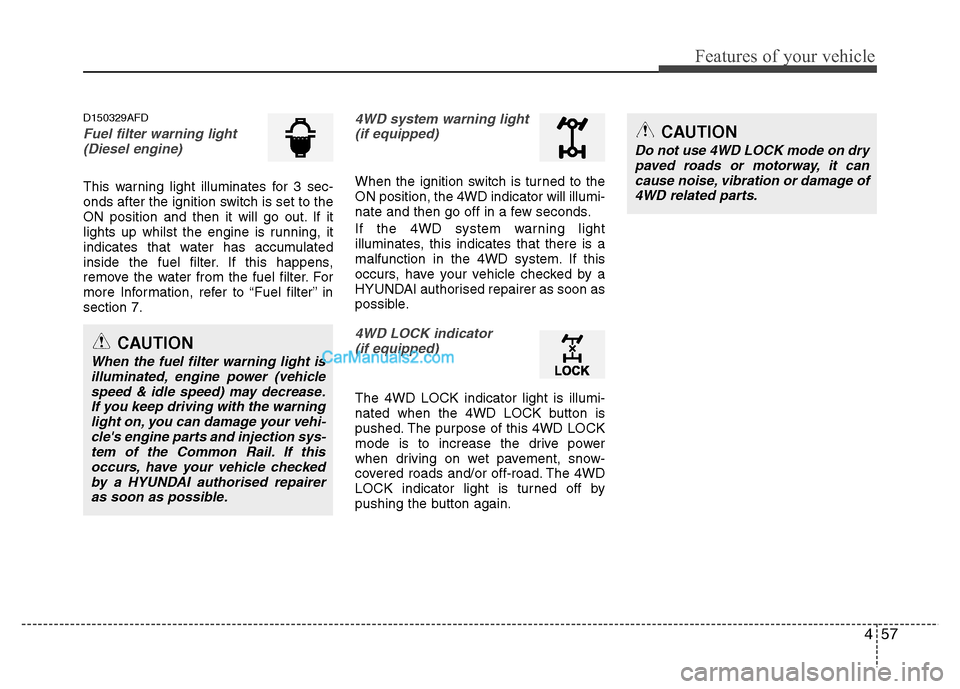
457
Features of your vehicle
D150329AFD
Fuel filter warning light(Diesel engine)
This warning light illuminates for 3 sec-
onds after the ignition switch is set to the
ON position and then it will go out. If it
lights up whilst the engine is running, it
indicates that water has accumulated
inside the fuel filter. If this happens,
remove the water from the fuel filter. For
more Information, refer to “Fuel filter” insection 7.
4WD system warning light(if equipped)
When the ignition switch is turned to the ON position, the 4WD indicator will illumi-
nate and then go off in a few seconds.
If the 4WD system warning light
illuminates, this indicates that there is a
malfunction in the 4WD system. If this
occurs, have your vehicle checked by a
HYUNDAI authorised repairer as soon as
possible.
4WD LOCK indicator (if equipped)
The 4WD LOCK indicator light is illumi-
nated when the 4WD LOCK button is
pushed. The purpose of this 4WD LOCK
mode is to increase the drive power
when driving on wet pavement, snow-
covered roads and/or off-road. The 4WD
LOCK indicator light is turned off by
pushing the button again.
CAUTION
When the fuel filter warning light is
illuminated, engine power (vehiclespeed & idle speed) may decrease.If you keep driving with the warning light on, you can damage your vehi-
cle's engine parts and injection sys-tem of the Common Rail. If thisoccurs, have your vehicle checkedby a HYUNDAI authorised repairer
as soon as possible.
CAUTION
Do not use 4WD LOCK mode on drypaved roads or motorway, it can
cause noise, vibration or damage of 4WD related parts.
Page 209 of 312
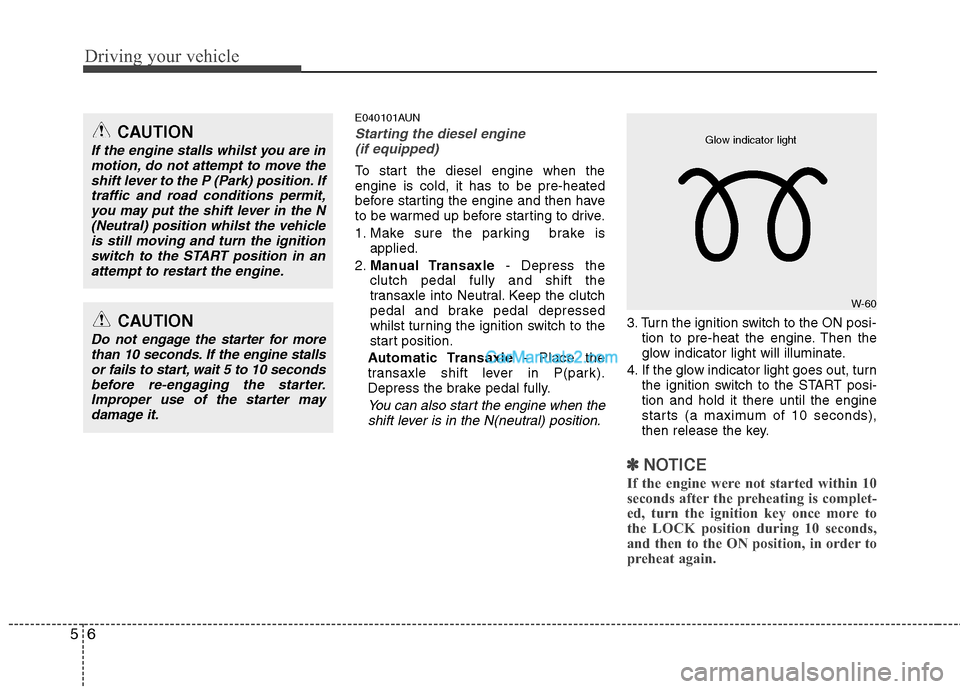
Driving your vehicle
6
5
E040101AUN
Starting the diesel engine
(if equipped)
To start the diesel engine when the engine is cold, it has to be pre-heated
before starting the engine and then have
to be warmed up before starting to drive.
1. Make sure the parking brake is applied.
2. Manual Transaxle - Depress the
clutch pedal fully and shift the
transaxle into Neutral. Keep the clutch
pedal and brake pedal depressed
whilst turning the ignition switch to the
start position.
Automatic Transaxle - Place the
transaxle shift lever in P(park).
Depress the brake pedal fully.
You can also start the engine when the
shift lever is in the N(neutral) position.
3. Turn the ignition switch to the ON posi- tion to pre-heat the engine. Then the
glow indicator light will illuminate.
4. If the glow indicator light goes out, turn the ignition switch to the START posi-tion and hold it there until the engine
starts (a maximum of 10 seconds),
then release the key.
✽✽
NOTICE
If the engine were not started within 10
seconds after the preheating is complet-
ed, turn the ignition key once more to
the LOCK position during 10 seconds,
and then to the ON position, in order to
preheat again.
W-60
Glow indicator lightCAUTION
If the engine stalls whilst you are in motion, do not attempt to move the
shift lever to the P (Park) position. Iftraffic and road conditions permit,you may put the shift lever in the N (Neutral) position whilst the vehicle
is still moving and turn the ignitionswitch to the START position in anattempt to restart the engine.
CAUTION
Do not engage the starter for morethan 10 seconds. If the engine stalls or fails to start, wait 5 to 10 secondsbefore re-engaging the starter.
Improper use of the starter maydamage it.
Page 214 of 312
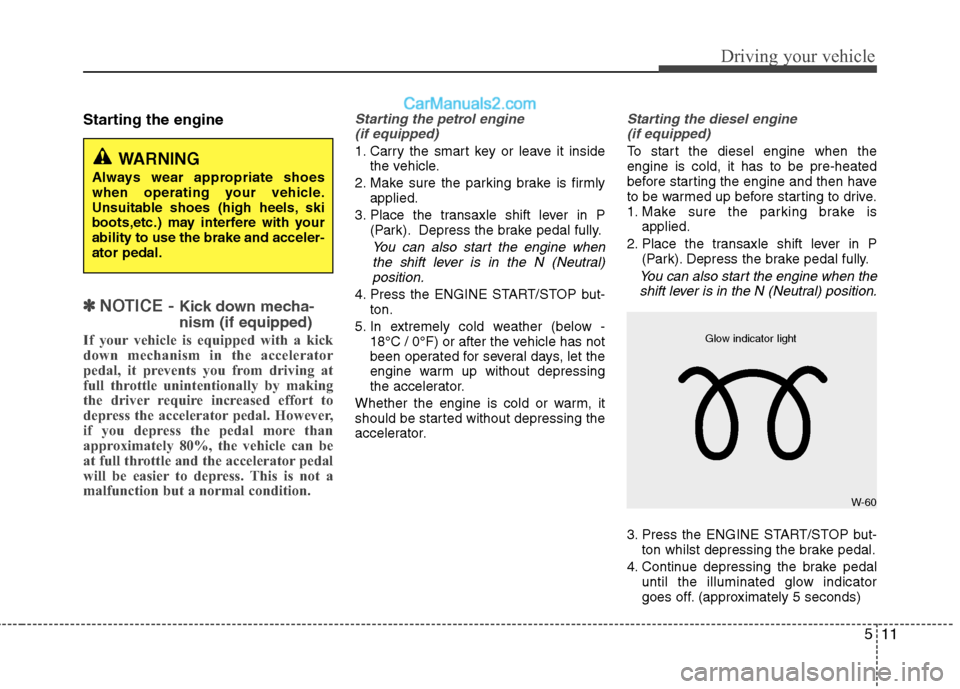
511
Driving your vehicle
Starting the engine
✽✽
NOTICE - Kick down mecha- nism (if equipped)
If your vehicle is equipped with a kick
down mechanism in the accelerator
pedal, it prevents you from driving at
full throttle unintentionally by making
the driver require increased effort to
depress the accelerator pedal. However,
if you depress the pedal more than
approximately 80%, the vehicle can be
at full throttle and the accelerator pedal
will be easier to depress. This is not a
malfunction but a normal condition.
Starting the petrol engine (if equipped)
1. Carry the smart key or leave it inside the vehicle.
2. Make sure the parking brake is firmly applied.
3. Place the transaxle shift lever in P (Park). Depress the brake pedal fully.
You can also start the engine when
the shift lever is in the N (Neutral)
position.
4. Press the ENGINE START/STOP but- ton.
5. In extremely cold weather (below - 18°C / 0°F) or after the vehicle has not
been operated for several days, let the
engine warm up without depressing
the accelerator.
Whether the engine is cold or warm, it
should be started without depressing the
accelerator.
Starting the diesel engine (if equipped)
To start the diesel engine when the engine is cold, it has to be pre-heated
before starting the engine and then have
to be warmed up before starting to drive.
1. Make sure the parking brake is applied.
2. Place the transaxle shift lever in P (Park). Depress the brake pedal fully.
You can also start the engine when the
shift lever is in the N (Neutral) position.
3. Press the ENGINE START/STOP but- ton whilst depressing the brake pedal.
4. Continue depressing the brake pedal until the illuminated glow indicator
goes off. (approximately 5 seconds)
WARNING
Always wear appropriate shoes
when operating your vehicle.
Unsuitable shoes (high heels, ski
boots,etc.) may interfere with yourability to use the brake and acceler-ator pedal.
W-60
Glow indicator light
Page 245 of 312
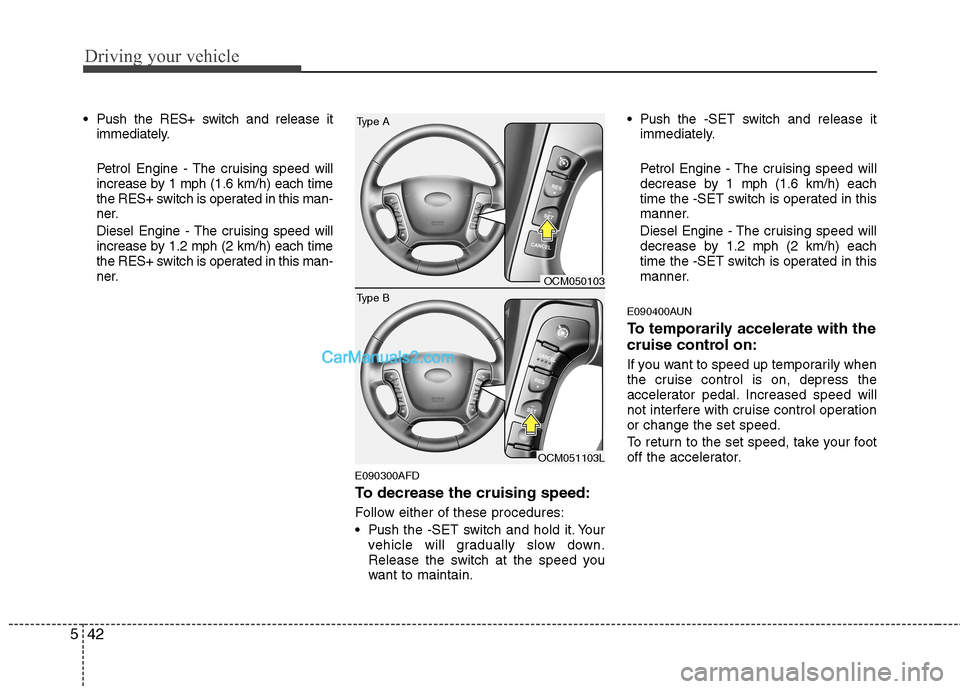
Driving your vehicle
42
5
Push the RES+ switch and release it
immediately.
Petrol Engine - The cruising speed will
increase by 1 mph (1.6 km/h) each time
the RES+ switch is operated in this man-
ner.
Diesel Engine - The cruising speed will
increase by 1.2 mph (2 km/h) each time
the RES+ switch is operated in this man-
ner.
E090300AFD
To decrease the cruising speed:
Follow either of these procedures:
Pushthe -SET switch and hold it. Your
vehicle will gradually slow down.
Release the switch at the speed you
want to maintain. Push
the -SET switch and release it
immediately.
Petrol Engine - The cruising speed will
decrease by 1 mph (1.6 km/h) each
time the -SET switch is operated in this
manner. Diesel Engine - The cruising speed will
decrease by 1.2 mph (2 km/h) each
time the -SET switch is operated in this
manner.
E090400AUN
To temporarily accelerate with the
cruise control on:
If you want to speed up temporarily when
the cruise control is on, depress the
accelerator pedal. Increased speed will
not interfere with cruise control operationor change the set speed.
To return to the set speed, take your foot
off the accelerator.
OCM050103
OCM051103L
Type A
Type B
Page 266 of 312
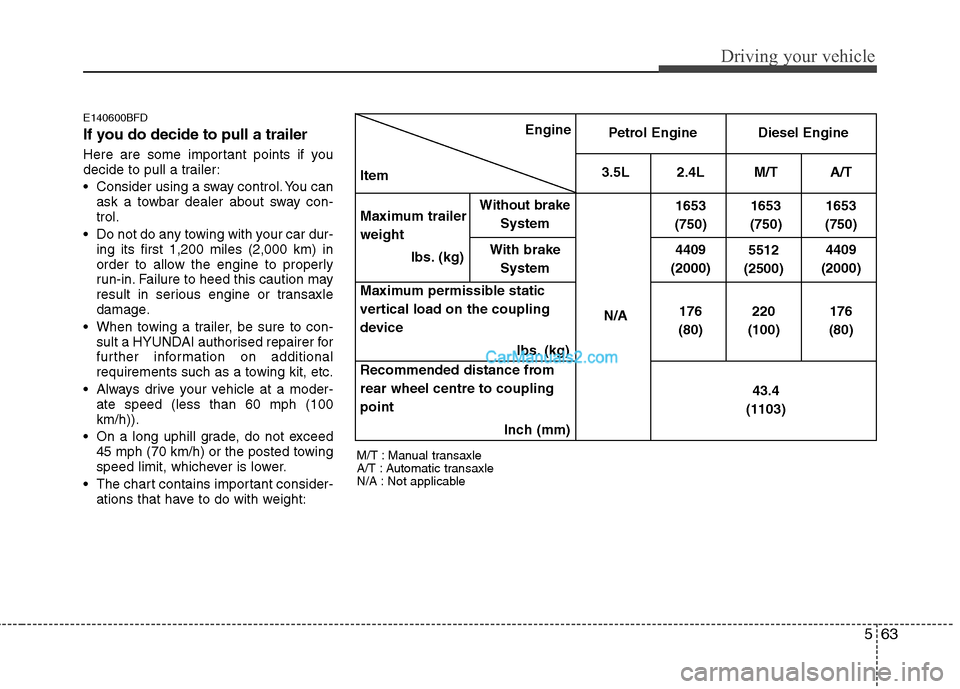
563
Driving your vehicle
E140600BFD
If you do decide to pull a trailer
Here are some important points if you
decide to pull a trailer:
Consider using a sway control. You canask a towbar dealer about sway con- trol.
Do not do any towing with your car dur- ing its first 1,200 miles (2,000 km) in
order to allow the engine to properly
run-in. Failure to heed this caution may
result in serious engine or transaxle
damage.
When towing a trailer, be sure to con- sult a HYUNDAI authorised repairer for
further information on additional
requirements such as a towing kit, etc.
Always drive your vehicle at a moder- ate speed (less than 60 mph (100km/h)).
On a long uphill grade, do not exceed 45 mph (70 km/h) or the posted towing
speed limit, whichever is lower.
The chart contains important consider- ations that have to do with weight: M/T : Manual transaxle
A/T : Automatic transaxle
N/A : Not applicableEngine
Item Petrol Engine Diesel Engine
3.5L 2.4L M/T A/T
Maximum trailer weight Ibs. (kg)
Without brake
System
N/A1653
(750) 1653
(750) 1653
(750)
With brake System 4409
(2000) 5512
(2500) 4409
(2000)
Maximum permissible static
vertical load on the coupling
device
Ibs. (kg) 176
(80) 220
(100) 176
(80)
Recommended distance fromrear wheel centre to couplingpoint Inch (mm) 43.4
(1103)
Page 298 of 312
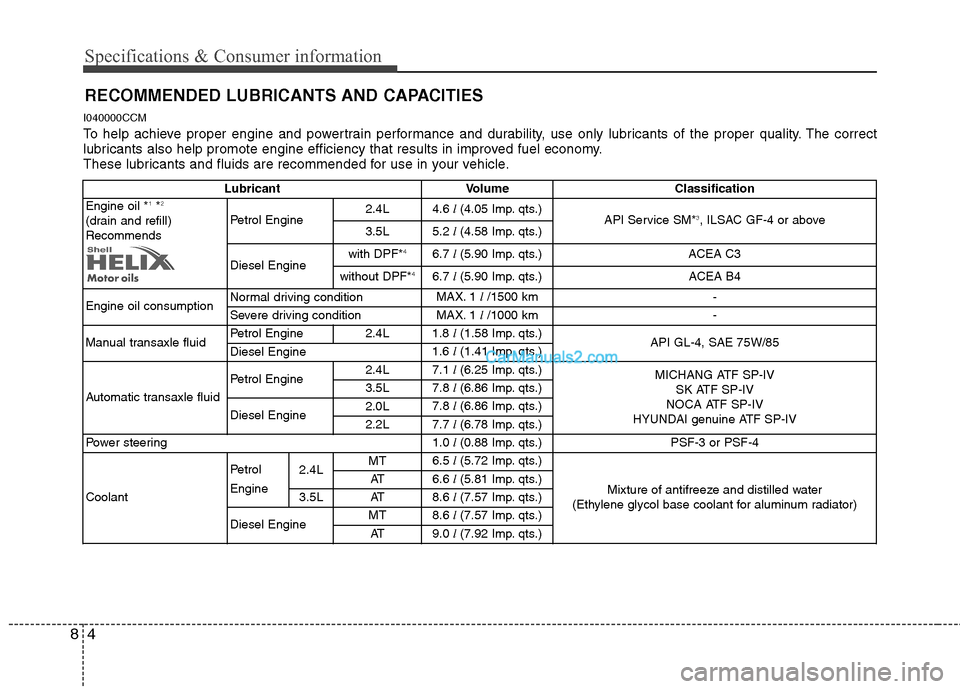
Specifications & Consumer information
4
8
RECOMMENDED LUBRICANTS AND CAPACITIES
I040000CCM
To help achieve proper engine and powertrain performance and durability, use only lubricants of the proper quality. The correct
lubricants also help promote engine efficiency that results in improved fuel economy.
These lubricants and fluids are recommended for use in your vehicle.
Lubricant Volume Classification
Engine oil * 1
*2
(drain and refill) Recommends Petrol Engine
2.4L
4.6
l (4.05 Imp. qts.)
API Service SM*3
, ILSAC GF-4 or above
3.5L 5.2
l (4.58 Imp. qts.)
Diesel Engine with DPF*
4
6.7 l (5.90 Imp. qts.)
ACEA C3
without DPF* 4
6.7 l (5.90 Imp. qts.)
ACEA B4
Engine oil consumption Normal driving condition
MAX. 1
l/1500 km
-
Severe driving condition MAX. 1
l/1000 km
-
Manual transaxle fluid Petrol Engine 2.4L
1.8
l(1.58 Imp. qts.)
API GL-4, SAE 75W/85
Diesel Engine 1.6
l(1.41 Imp. qts.)
Automatic transaxle fluid Petrol Engine
2.4L
7.1
l (6.25 Imp. qts.)
MICHANG ATF SP-IV
SK ATF SP-IV
NOCA ATF SP-IV
HYUNDAI genuine ATF SP-IV
3.5L
7.8
l (6.86 Imp. qts.)
Diesel Engine 2.0L
7.8
l (6.86 Imp. qts.)
2.2L 7.7
l (6.78 Imp. qts.)
Power steering 1.0
l (0.88 Imp. qts.)
PSF-3 or PSF-4
Coolant Petrol Engine
2.4L
MT
6.5
l (5.72 Imp. qts.)
Mixture of antifreeze and distilled water
(Ethylene glycol base coolant for aluminum radiator)
AT
6.6
l (5.81 Imp. qts.)
3.5L AT 8.6
l (7.57 Imp. qts.)
Diesel Engine MT
8.6
l (7.57 Imp. qts.)
AT 9.0
l (7.92 Imp. qts.)
Page 299 of 312

85
Specifications & Consumer information
LubricantVolume Classification
Brake/clutch fluid 0.7~0.8
l
FMVSS116 DOT-3 or DOT-4
(0.62~0.70 Imp. qts.)
Rear differential oil (4WD) 0.7 l (0.62 Imp. qts.) HYPOID GEAR OIL API GL-5, SAE 75W/90
(SHELL SPIRAX X or equivalent)
Transfer case oil Petrol Engine 2.4L 0.6
l (0.53 Imp. qts.)
HYPOID GEAR OIL API GL-5, SAE 75W/90
(4WD) 3.5L 0.7
l (0.62 Imp. qts.)
Diesel Engine 0.6 l (0.53 Imp. qts.) (SHELL SPIRAX X or equivalent)
Fuel 70 l (15.40 lmp. gal.) Refer to “Fuel requirements” in section 1
*1
Refer to the recommended SAE viscosity numbers on the next page.
* 2
Engine oils labeled Energy Conserving Oil are now available. Along with other additional benefits, they contribute to fuel economy by reducing
the amount of fuel necessary to overcome engine friction. Often, these improvements are difficult to measure in everyday driving, but in a year’s
time, they can offer significant cost and energy savings.
* 3
If the API service SM engine oil is not available in your country, you are able to use API service SL.
* 4
Diesel Particulate Filter
MT : Manual transaxle
AT : Automatic transaxle
Page 300 of 312

Specifications & Consumer information
6
8
I040100AXM Recommended SAE viscosity
number Engine oil viscosity (thickness) has an
effect on fuel economy and cold weather
operating (engine start and engine oil
flowability). Lower viscosity engine oils
can provide better fuel economy and cold
weather performance, however, higher
viscosity engine oils are required for sat-
isfactory lubrication in hot weather. Using
oils of any viscosity other than those rec-ommended could result in engine dam-
age.When choosing an oil, consider the range
of temperature your vehicle will be oper-
ated in before the next oil change.Proceed to select the recommended oil
viscosity from the chart.
CAUTION
Always be sure to clean the area
around any filler plug, drain plug, ordipstick before checking or drain-ing any lubricant. This is especially
important in dusty or sandy areasand when the vehicle is used on unpaved roads. Cleaning the plugand dipstick areas will prevent dirt
and grit from entering the engine and other mechanisms that couldbe damaged.
Temperature Range for SAE Viscosity Numbers
Temperature
Petrol
Engine Oil * 1°C
(°F)-30 -20 -10 0 10 20 30 40 50 -10 0 20 40 60 80 100 120
Diesel
Engine Oil
5W-30
15W-40
10W-30
0W-30/40
* 1
: For better fuel economy, it is recommended to use the engine oil of a viscosity grade SAE
5W-20 (API SM / ILSAC GF-4). However, if the engine oil is not available in your country,
select the proper engine oil using the engine oil viscosity chart.
20W-50
10W-30
15W-40
5W-20, 5W-30